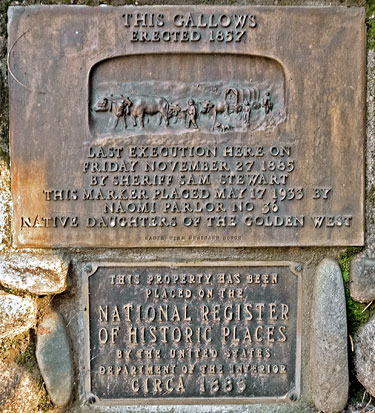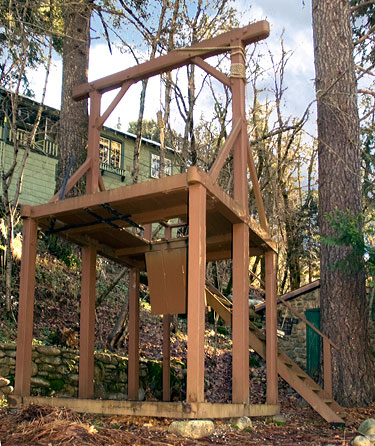National Register of Historic Places in Sierra County

This Gallows Erected 1857
Last execution here on Friday November 27 1885
By Sheriff Sam Stewart
This marker placed May 17 1933 by Naomi Parlor No 36
Native Daughters of the Golden West
 This property has been placed on the
This property has been placed on the
National Register of Historic Places
By the United States Department of the Interior
Circa 1885
Both Photos 14 December 2005
(Click Photos to Zoom)
Sierra County Sheriff's Gallows
Galloway Road and Courthouse Square
Downieville
Year 1885
This structure is the only authentic standing gallows in California. One gallows remains in storage in Napa County, and there is an accurate replica of a gallows at Shasta State Historic Park.
Sierra County was not one of the original California Counties created in 1850. For seventeen months, from 1850 to 1852, the land now included in Sierra County was part of Yuba County. The Yuba County courthouse in Marysville was far from Downieville. Lynchings were the accepted form of justice.
The first legal execution in Sierra County occurred in 1853 when Indian "Pijo" was executed for killing two Chinese miners. In 1856, Mordecai Harlow was executed for a murder at La Porte. In 1859, Michael Murry was hanged for an 1857 murder at Poker Flat.
All three of these legal executions were conducted in Downieville, adjacent to the county courthouse, and were by hanging. No details survive as to the specific method used, in either 1853 or 1856, but by 1859 a mechanically operated trip hook using a counter weight was used.
The last hanging occurred in 1884 when young James O'Neill, a native of Ireland, shot and killed his employer during an argument. O'Neill was found guilty of murder in a trial a jury and sentenced to death by hanging. The California Supreme Court affirmed the judgment and sentence.
On Thursday, November 26, 1885, at the request of the county sheriff, a wooden gallows was built by local carpenters and erected in a yard adjacent to the original Sierra County Courthouse. The following afternoon, at the time affixed by the court, the hanging of James O'Neill was to be the last legal execution within Sierra County.
The gallows was designed to be portable. It was dismantled and stored in the attic of the courthouse until its use was again warranted.
In 1891, the California State Legislature mandated that all future executions be conducted at the state level, either at San Quentin Prison or Folsom Prison. In 1941, California ended hanging as a means of execution, replacing it with the gas chamber at San Quentin.
From 1885 until 1927, the gallows remained forgotten in the attic of the courthouse. Discovered by county employees in 1927, it was reassembled adjacent the courthouse. Over the years, as the gallows deteriorated, it was shored up with cross bracing and structural steel.
In 1988, the gallows was restored to its 1885 appearance.
Adapted from the NRHP nomination.

